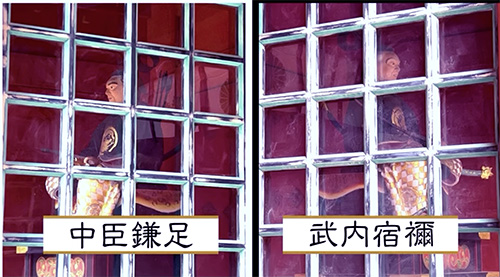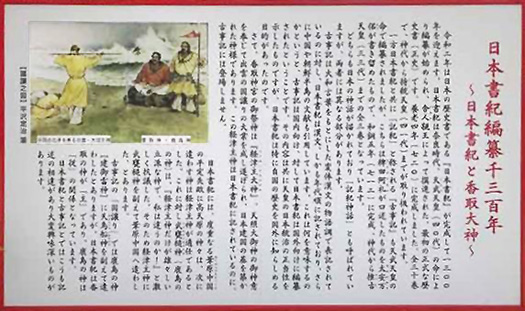

香取神宮をめぐってその霞のような上代の様子を眺めると、やはり蝦夷、東北地域の制圧に向けた軍事上の重要拠点だったことが露わになってくる。香取神宮の祭神・経津主大神(ふつぬしのおおかみ)は奈良の春日大社でも祀られるとともに、王権による蝦夷制覇の象徴のように仙台の近くの「鹽竈神社」にも祀られている。
中央王権による東北進出は、幾度かの日本史上の戦乱期、前九年後三年合戦や頼朝による奥州征伐などが想起されるけれど、この香取−鹿島が日本中央の畿内地域から東北に至る交通上の最重要な結節点になっていて、兵員輸送や軍需物資の輸送などの基地になっていたと思える。東北地域での輸送受け入れ先港湾としての塩竃の位置関係も見てみれば、このことは類推しやすい。
現代でも、太平洋航路としてのフェリーでは苫小牧ー仙台ー大洗という物流の大動脈ルートがあるように東北と関東はこういったルートをたどった可能性が高い。
日本書紀記述で武内宿禰が東北・蝦夷の地域を「撃ちて取るべし」と上申した旨を記したけれど、この香取神宮本殿に至る「楼門」を守護する狛犬の位置に、武内宿禰が配置され、相方には,香取と縁の深い春日大社を造営した藤原氏の始祖・中臣鎌足が鎮座している。畿内地域と東北とを繋ぐ交通上の要地としての香取神宮をそのように表現していると見える。
日本の中央王権は、古代に於いて薩摩隼人も制圧したとされ、その拠点として宇佐神宮があり、こちらもその武徳を表すように「八幡神」が祀られている。八幡は鎌倉の鶴岡にも祀られる武神。
事業として北海道から東北に広げ、そこから関東を見晴らすときに、この香取神宮や鹿島神宮に不思議と導かれるように参詣させていただいたのには、そういう縁があるのかも知れません(笑)。北海道人としては、こういうカムバック・ジャパンという道もあるかもと勝手に思う。
祭神としての経津主大神の活躍ぶりは、以下の葦原の中つ国草創神話にも記される。

神話では天照大神が日本国草創を意図したときに、当時日本列島を治めていた出雲大社の神を制圧するのに2度失敗した後、3度目の正直として遣わされたのが香取の経津主大神であったのに、鹿島の武甕槌大神(タケミカヅチ)が激しく自己主張して同道したのだとされる。このイラストでは経津主大神がしっかりと坐っているのに、武甕槌大神は付随しているような描かれ方をしている。また、日本書紀ではそのように書かれているのに、古事記には経津主大神は記述されていないとされている。
この両神間ではどのような相関関係であったか、ちょっと心配にもなる(笑)。しかしその後の歴史ではこうした地域間対立のようなことは記録もない。
English version⬇
Katori Jingu (Katori Jingu Shrine 3), the Gate of the Tower and the Statue of Asaomi [Exploring the Three Shrines of Eastern Japan – 17].
Katori’s strategic location is historically important for the formation of a unified state by the central Japanese monarchy. A strategic strategic point. The god of worship, Kyotsunushi, is enshrined both in Nara and in Yanagama. ・・・・.
When we look at the hazy Upper Period scene surrounding Katori Jingu Shrine, it becomes clear that it was an important military base for the conquest of the Emishi and Northeast regions. The deity of Katori Jingu, Futsunushi no Okami, is also enshrined at Kasuga Taisha Shrine in Nara, as well as at the nearby Shiogama Shrine in Sendai, symbolizing the conquest of the Emishi by the royal power.
The expansion into the Tohoku region by the central royal power is reminiscent of several periods of warfare in Japanese history, such as the Nine Years’ War in the Former Nine Years and Three Years’ War in the Later Three Years, and the conquest of Oshu by Yoritomo (1467-1568). It seems that Kashima was the most important transportation node from the Kinai region in central Japan to the Tohoku region. This is easily analogized by looking at Shiogama’s position as a port for receiving transportation in the Tohoku region.
Even today, the Tohoku and Kanto regions are likely to have followed this route, as in the case of the Pacific Ocean ferry route Tomakomai – Sendai – Oarai, which is a major logistics artery route.
In the Nihon-shoki (Chronicles of Japan), it is written that Takeuchi Sukune (the founder of the Fujiwara Clan) proposed that the Tohoku and Emishi regions “should be taken by shooting”. Takeuchi Sukune is placed in the position of the guardian dogs that guard the “tower gate” leading to the main shrine of Katori Jingu, and on the other side sits Nakatomi Kamatari, founder of the Fujiwara Clan who built the Kasuga Grand Shrine, which is closely related to Katori. The shrine appears to represent Katori Jingu Shrine as such, as a strategic location for transportation between the Kinai region and the Tohoku region.
In ancient times, the Satsuma Hayato also suppressed the central Japanese royal power, and Usa Jingu Shrine is located at the center of this power, where the Hachiman deity is enshrined as a symbol of their military virtue. Hachiman is also a warrior god enshrined at Tsuruoka in Kamakura.
When I expanded my business from Hokkaido to Tohoku and looked out over the Kanto region from there, I may have been mysteriously led to this Katori Jingu Shrine and Kashima Jingu Shrine to pay homage to them (laugh). As a Hokkaido-jin, I selfishly think that there may be such a way of come-back Japan.
The activities of Kyotsunushi no Mikoto as a deity are described in the following myth of the creation of the Land of Reed Plains.
According to mythology, when Amaterasu intended to create Japan, he failed twice to subdue the deity of Izumo-taisha, which ruled the Japanese archipelago at the time, and sent him to Katori as his third attempt. In this illustration, the deity Kyotsunushi is firmly seated, but Takemikazuchi is depicted as if he were an incidental deity. In addition, the Kojiki (Records of Ancient Matters) does not mention Kyotsunushi no Mikami, even though the Nihon Shoki (Chronicles of Japan) does.
It is a little worrisome what kind of correlation there was between these two deities (laughs). However, there is no record of any such interregional conflict in subsequent history.
Posted on 8月 22nd, 2023 by 三木 奎吾
Filed under: 日本社会・文化研究, 歴史探訪







コメントを投稿
「※誹謗中傷や、悪意のある書き込み、営利目的などのコメントを防ぐために、投稿された全てのコメントは一時的に保留されますのでご了承ください。」
You must be logged in to post a comment.